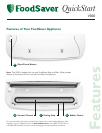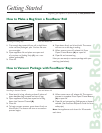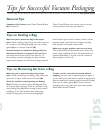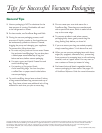
Copyright © 2004 Tilia, Inc. All rights reserved. This material may not be reproduced or redistributed in any fashion without the express written consent of Tilia, Inc.
FoodSaver and the Freshness Shield logo are trademarks or registered trademarks of Tilia Int’l, Inc. in the United States and other countries. All other trademarks
are property of their respective owners. Tilia, Inc. and Tilia Int’l, Inc. are Jarden companies. This product is protected by one or more of the following Patents:
U.S. RE 34,929; 4,660,355; 4,941,310; 5,655,357; 6,058,998; 6,256,968; Canada 1,315,746; and their equivalent international patents.
First Printing: 9/2004 Item # T180-00213-000 (9/04)
General Tips
Tips for Successful Vacuum Packaging
(continued)
1. Vacuum packaging is NOT a substitute for the
heat process of canning. Perishables still need
to be refrigerated or frozen.
2. For best results, use FoodSaver Bags and Rolls.
3. During the vacuum packaging process, small
amounts of liquids, crumbs or food particles can
be inadvertently pulled into Vacuum Channel,
clogging the pump and damaging your appliance.
To prevent this, follow these tips:
a. For moist and juicy foods such as raw meats: Freeze
first and avoid overfilling bags. You can also place
a folded paper towel inside top of bag, but
below seal area, before vacuum packaging.
b. For soups, sauces and liquids: Freeze first and
avoid overfilling bags.
c. For powdery or fine-grained foods:
Avoid overfilling bags. You can also place
a coffee filter or paper towel inside before
vacuum packaging.
4. To avoid overfilling, always leave at least 3 inches
of bag material between bag contents and top of
bag. Then leave at least one additional inch of bag
material for each time you plan to reuse bag.
5. Do not create your own side seams for a
FoodSaver Bag. These bags are manufactured
with a special side seam, which is sealed all the
way to the outer edge.
6. To prevent wrinkles in seal when vacuum
packaging bulky items, gently stretch bag flat
along Sealing Strip before you close lid.
7. If you are unsure your bag was sealed properly,
simply reseal bag about
1
⁄
4 inch above first seal.
8. When you are vacuum packaging items with sharp
edges (dry spaghetti, silverware, etc.), protect bag
from punctures by wrapping item in soft cushioning
material, such as a paper towel. You may want to
use a canister or Mason jar instead of a bag.
9. Pre-freeze fruits and blanch vegetables before
vacuum packaging for best results. See pages 2-3
of
FoodSaver Reference Guide for more information.






